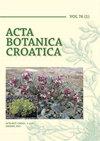日则(北缅甸)Fırtına谷地永久野杨林的附生苔藓演替
IF 0.7
4区 生物学
Q3 PLANT SCIENCES
引用次数: 0
摘要
在本研究中,对土耳其九个生物多样性热点之一的Fırtına山谷(ÇamlıhemşIn Rize,North Turkiy)的黄杨森林的附生苔藓植物演替进行了调查。为此,共从不同树龄的B.sempervirens树的活树干上采集了60个采样点。在样地内测定了29种附生苔藓植物(24种苔藓和5种苔类)。此外,还确定了六种不同的生命形式类型和四种不同的栖息地亲和力类别。垫型生活型居首位,占34.4%,而皮质苔藓种类最为常见,占51.7%。双向指示种分析(TWINSPAN)将粗茎B.sempervirens树干上的附生苔藓植物群落分为两个主要类群(A和B)和三个亚类群(A1、B1和B2)。去趋势对应分析(DCA)轴1被解释为树干上沿附生生境高度(从下基底到上部区域)的梯度,DCA轴2被解释为水分梯度(从中湿到xeric)。Exsertotheca crispa(Hedw.)S.Olsson,Enroth&D.Quandt是在老化树木的下基具有最高生态意义指数(IES)值的物种。研究区上部带的物种多样性和附生覆盖率低于基底带和中部带。虽然Metzgeria furkata、(L.)Corda、Oxyrhynchium hians(Hedw.)Loeske、Plagiothecium nemorale(Mitt.)A.Jaeger和Radula lindenbergiana Gottsche ex C.Hartm只在老树上发现,但软体Ctenidium(Hedw)Mitt。和Pseudoleskeella nervosa(Brid.)Nyholm只在中年树上发现。本文章由计算机程序翻译,如有差异,请以英文原文为准。
The epiphytic bryophyte succession of Buxus sempervirens forests in the Fırtına Valley, Rize (North Türkiye)
In this study, the epiphytic bryophyte succession of the Buxus sempervirens L. forests in Fırtına Valley (Çamlıhemşin-Rize, North Türkiye), one of the nine biodiversity hotspots in Türkiye, were investigated. For this purpose, a total of 60 sampling plots were taken from the live trunks of the B. sempervirens trees of different ages. Twenty-nine epiphytic bryophyte species were determined (24 mosses and 5 liverworts) within the sample plots. Also, six different life form types and four different habitat affinity categories were determined. The mat type life form is in the first place with 34.4% whereas the and cortico-saxicolous species are the most common with 51.7%. Two-Way Indicator Species Analysis (TWINSPAN) classified the epiphytic bryophyte communities on the trunks of the B. sempervirens at the second level into two main clusters (A and B) and three sub-clusters (A1, B1 and, B2). Detrended Correspondence Analysis (DCA) axis 1 was interpreted as gradient along the height of the epiphytic habitat (from the lower base to the upper zone) on trunks and the DCA axis 2 was interpreted as gradient of moisture (from mesic to xeric). Exsertotheca crispa (Hedw.) S.Olsson, Enroth & D.Quandt was the species with the highest Index of Ecological Significance (IES) value on the lower bases of the aged trees. Species diversity and epiphytic cover in the upper zones were lower than in the basal and middle zones in the study area. While Metzgeria furcata, (L.) Corda, Oxyrrhynchium hians (Hedw.) Loeske, Plagiothecium nemorale (Mitt.) A.Jaeger, and Radula lindenbergiana Gottsche ex C.Hartm were only found on old trees, Ctenidium molluscum (Hedw.) Mitt. and Pseudoleskeella nervosa (Brid.) Nyholm were only found on middle-aged trees.
求助全文
通过发布文献求助,成功后即可免费获取论文全文。
去求助
来源期刊

Acta Botanica Croatica
PLANT SCIENCES-
CiteScore
2.50
自引率
0.00%
发文量
34
审稿时长
>12 weeks
期刊介绍:
The interest of the journal is field (terrestrial and aquatic) and experimental botany (including microorganisms, plant viruses, bacteria, unicellular algae), from subcellular level to ecosystems. The attention of the Journal is aimed to the research of karstic areas of the southern Europe, karstic waters and the Adriatic Sea (Mediterranean).
 求助内容:
求助内容: 应助结果提醒方式:
应助结果提醒方式:


